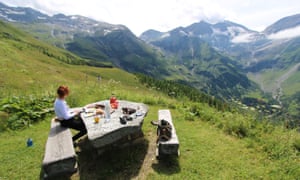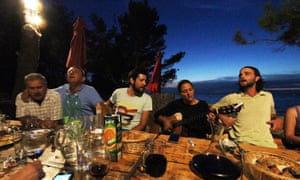 |
| View from the Kamp Lili campsite on Hvar island in Croatia. Photograph: Kevin Rushby for the Guardian |
On the first leg of a road trip to the Balkans and the Baltic, our writer and his family hurtle through the rain to reach the brilliant sunshine of Croatia
By the time we disembark from the ferry at Zeebrugge, I’m wondering if our great European adventure is going to be sunless. The drab landscape is apparently hammered flat by cold rain. We turn south-east and drive all morning, until a horrible rattle from under the car starts just before the Luxembourg border.
The whole idea for this escapade came from a feeling that eastern and central Europe are a vast under-explored region – particularly by me. I’m more familiar with Papua New Guinea than Poland, or any one of a dozen other European countries. In a cold English spring I sketched out a plan for a massive summer road trip, an ambitious loop around the Balkans, then up through Europe as far as the Baltic. I calculated the distances – around 5,000 miles – and decided six weeks would be sufficient.
The route threw up immediate questions. Does British vehicle insurance cover Albania? Answer: normally, no. I switched companies. What other paperwork and equipment was required? Answer: lots. Green cards, vignettes, international driving permits (1949 convention), a fire extinguisher, a Croatian fishing licence and more. On the last shopping day before departure, I filled the car with an inflatable canoe and piles of outdoor gear. My wife Sophie and daughter Maddy (12) refused to allow a speargun, but compromised on the lobster pot.
On that road near Luxembourg we discover that our car’s front trim is hanging off, but rattle on into Germany and spend a superb first night at Camping am See near Augsburg. The next day we wind up through the Alps, avoiding motorways and piercing the ghost of the iron curtain at the Wurzen Pass on the Austrian border before arriving at Slovenia’s Lake Bled.
The next day, still in heavy rain, we enter Croatia and the sun emerges. Our first stop is Pag Island, which we reach via a ferry from the fishing port of Prizna. The queue for the ferry is massive and filled with young men high on Red Bull, beer and the rest. Pag, they tell us, is a party island. Sophie pulls me aside. “Aren’t you writing about the best, most secluded spots in Croatia?” I nod, a little nervously. I’m hoping my contacts are not mistaken.
Pag itself is like a bone: wind-dried and white. We leave the partygoers behind (they all head for the beaches around the town of Novalja) and find an elemental landscape with stirring views of an improbably blue sea. On every corner there is someone selling home-grown olive oil, liquors and cheese – home-produced shopping that is to prove one of the great pleasures of Croatia. We stock up onprošek (a thick sweet dessert wine), paški sir (the island’s own rich, salty sheep’s cheese) and olive oil, then locate Branimir, the owner of the cottage we are booked into. He adds to our shopping a bottle of his father’s travarica, a spirit infused with 12 herbs, and takes us to a little stone cottage by the sea with a shady terrace and steps to a rocky shoreline.
We explore the coast by canoe and soon realise that selecting the “10 best beaches of Croatia”, as some websites do, is like picking the 10 best stars from the Milky Way. Everywhere we look there are perfect little coves and clear deep blue water speckled with schools of fish that are far too wily to be caught. At the northern end of the island we discover the ancient olive groves of Lun, a 24-hectare (60 acre) labyrinthine marvel of curving stone walls and trees that date back an average of 1,200 years – one tree is 1,600 years old. Inevitably, there are perfect small coves for swimming.
Croatia, you might think, has long been on the tourist radar. Back in 1964 Alfred Hitchcock declared the sunsets from Zadar, south of Pag, the best on Earth. But the truth is that most visitors head for a few well-known spots, leaving many areas to be discovered. The north has some fantastic islands such as Rab (great sandy beaches and historic town), Cres (griffon vultures fly over this idyllic island) and Silba (not even bicycles are allowed to disturb the peace). Further south you could try Šolta or Vis, both accessible by ferry from Split. There are 47 inhabited islands – a further 671. The inflatable canoe, I declare to a sceptical family, is ready.
One evening Branimir invites us to a beach party at the secluded cove of Girenica, where we drink fine red wine from the Pelješac peninsula and eat grilled fish followed by fritules, sweet dumplings. A guitar appears and everyone sings Croatian songs which are, apparently, all about love or the sea. One of Branimir’s mates even fixes our car and when we move on, southwards, we don’t rattle any longer.
The Croatian mainland coast is 1,104 miles (1,777km) long and we cover a lot of it over the next few days. Island hopping with a car seems relatively simple: turn up at a port, buy a ticket and wait until there is space. Waiting was never so easy: you swim off the sea walls, picnic and shift the car when need be. On the island of Hvar, a lush contrast to Pag’s austere moonscape, we drive through a mile-long single-track tunnel and emerge to find the idyllic Kamp Lili campsite, a clutch of tents under shady pines with several coves to swim around.
There are few reminders of the Balkan war of the 1990s here, but there is a 25km section of Bosnia-Herzegovina to negotiate before Croatia resumes. Here, in the town of Neum, the atmosphere is suddenly very different: ladies in stout swimwear lying in the shade of the bombed-out post office, a victim of Serbian army artillery. This tiny corridor of land was ceded to the Ottoman Empire in 1699, a buffer between the independent city state of Dubrovnik and the then Venetian-controlled north. We push on south, back into Croatia, stopping briefly in stylish Dubrovnik, then onwards, as I write, through Montenegro, heading for our next stop, Albania. The adventure is definitely under way.
• Ferry crossing was provided by P&O Ferries (Hull-Zeebrugge one way for a car plus two adults and one child, with cabin from £200, poferries.com). Accommodation on Pag island was provided by Croatia Tourism (croatia.hr): House Tomislav can be booked through Adriagate (adriagate.com) which has a range of cottages on the mainland and islands, some only accessible by boat, from £16pppn. Camping am See (tent and car £6, adults £5, children £3, bauer-caravan.de; Camping Bled (from £16 for tent plus two adults, sava-hotels-resorts.com); Kamp Lili (£6 per adult, children £3, under three free, price includes tent and car,kamplili.hr). For information on Croatian ferries see (jadrolinija.hr/en/ferry-croatia)
Books: Kevin read Rebecca West’s classic travelogue Black Lamb and Grey Falconwhich he says “is proving to be an astonishing companion, full of memorable images and quotations: ‘I had come to Yugoslavia to see what history meant in flesh and blood.’”
By Kevin Rushby




No comments:
Post a Comment